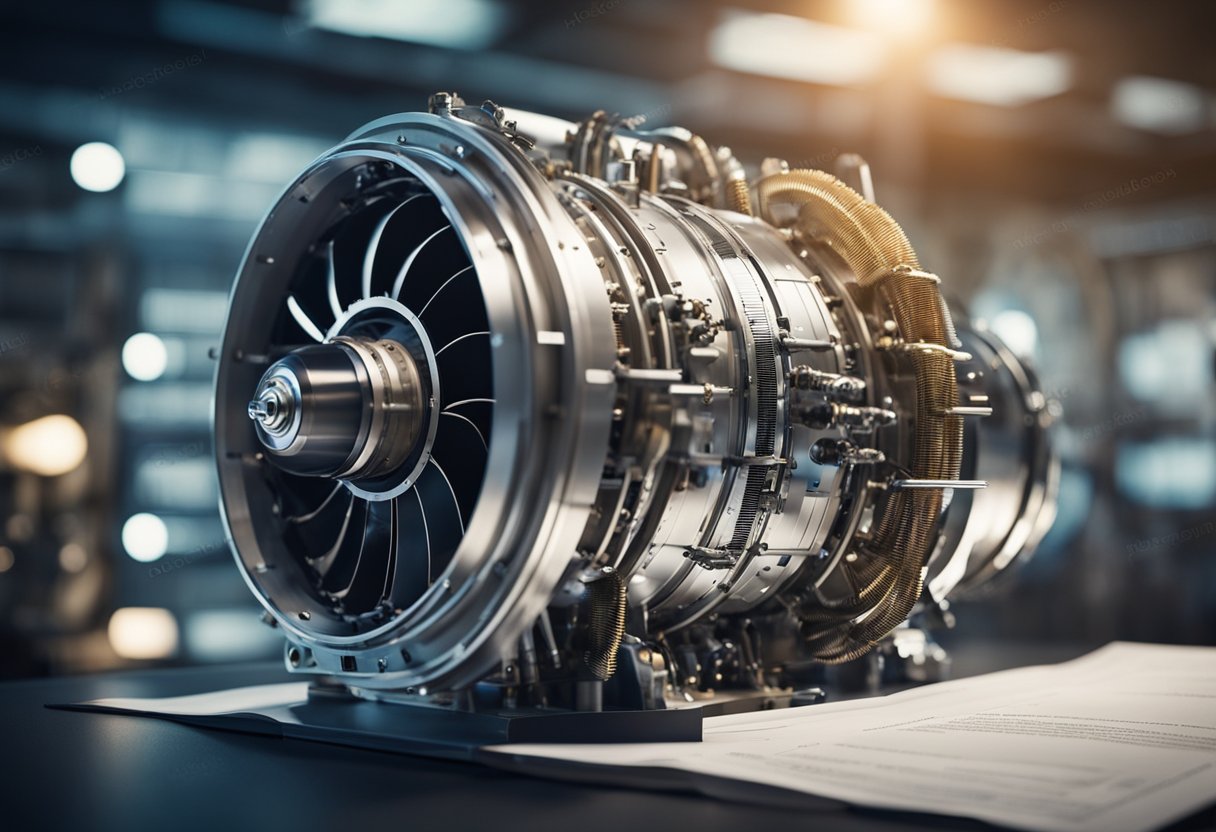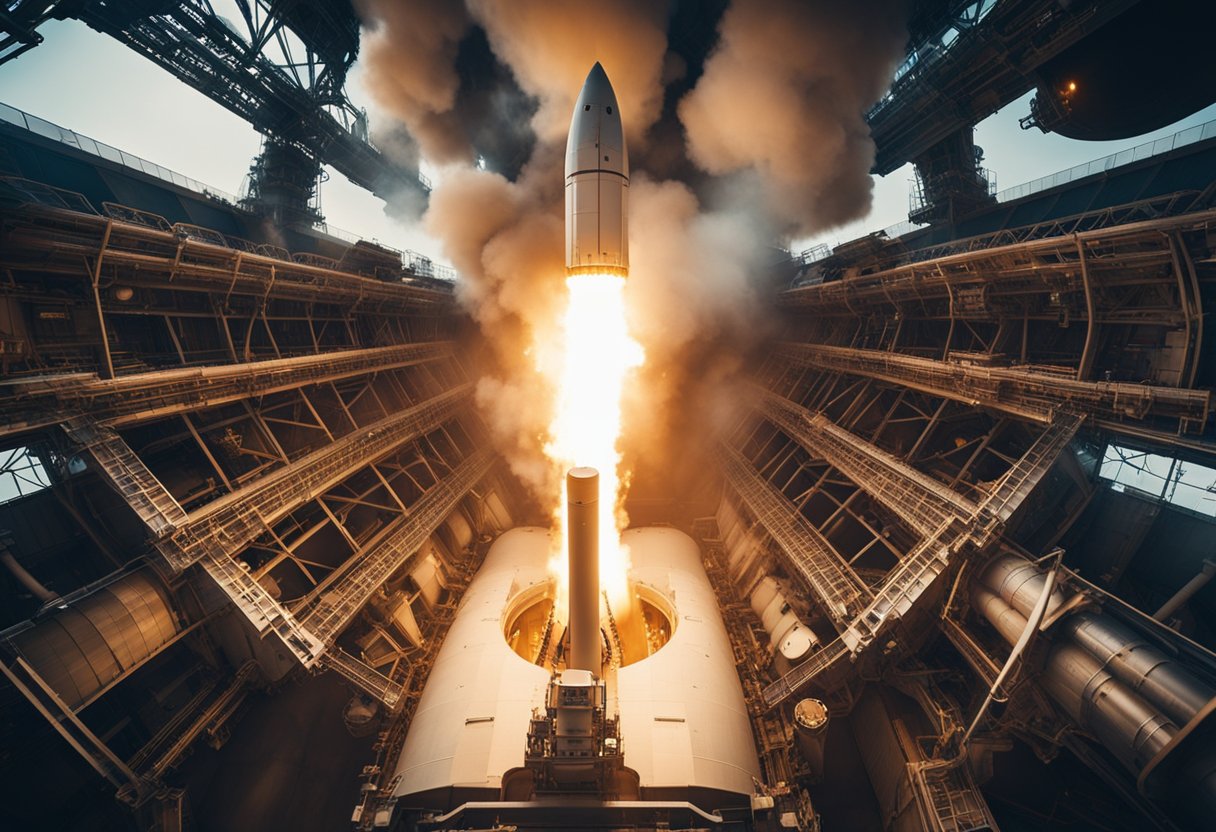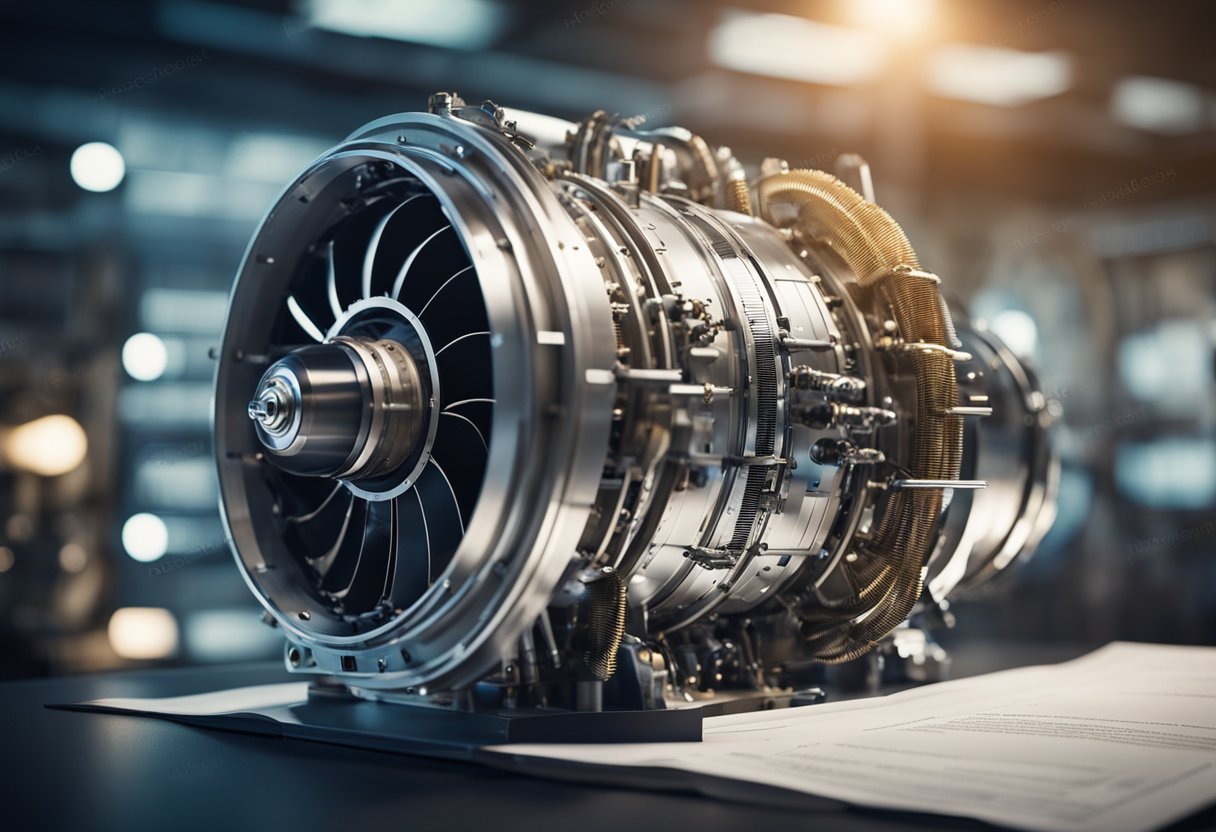
Nuclear thermal propulsion (NTP) holds the promise of revolutionising space exploration. Offering significantly better efficiency over traditional chemical rockets, this technology utilises a nuclear reactor to heat a propellant, such as hydrogen, to produce thrust. The high thrust paired with a greater propellant efficiency could shorten journey times to Mars and beyond, opening up a realm of possibilities for both human and robotic deep space missions.

Our exploration of the cosmos stands on the cusp of a new era thanks to the advancements in NTP. Current developments are focusing on enhancing the safety and performance of these propulsion systems, which include considering the use of low-enriched uranium as fuel. As we look to the future, NTP is poised to become a cornerstone technology for ambitious missions to Mars and other distant locales, rendering them more feasible and within a more practical timeframe.
As experts in the field, we understand that exploring the vast cosmos necessitates incredible technologies. Nuclear thermal propulsion (NTP) represents one such groundbreaking advancement, providing more efficient travel in the forbidding expanse of space.
Nuclear thermal propulsion operates on a principle where reactors generate heat through fission—the splitting of atomic nuclei. This immense thermal energy heats a fuel, typically hydrogen, to a high temperature before expelling it through a nozzle to produce thrust. Key to this process is specific impulse, a measure of propulsion efficiency. NTP systems boast a higher specific impulse than traditional rockets, owing to the greater energy density of nuclear reactions compared to chemical ones.
Undeniably, NTP features several benefits over conventional chemical propulsion:
By applying our advanced understanding of NTP, we endeavour to surmount space travel’s current limitations, unlocking a future where the cosmos is within easier reach.
In our exploration of deep space, the adaptation of nuclear thermal propulsion offers a significant leap in performance over conventional chemical rockets. This advanced technology utilises nuclear reactors to generate immense heat, expelling propellant at high speeds, thus propelling spacecraft with greater efficiency.
The core of a Nuclear Thermal Rocket (NTR) lies in its nuclear engine, specifically a fission reactor. Within this reactor, atoms are split to release energy, dramatically increasing the temperature of the propellant. The heated propellant is then expelled to produce thrust. Given the high energy density of nuclear fuel, NTRs can achieve far higher specific impulse compared to chemical rockets.
The NERVA Program was a pioneering initiative during the 1960s and early 70s aiming to develop a nuclear rocket engine for manned missions to Mars. Although the program was eventually canceled, it successfully demonstrated the feasibility of nuclear thermal rockets. The knowledge gleaned from NERVA continues to inform our efforts in advancing nuclear propulsion technologies.
In the arena of deep-space exploration, nuclear thermal propulsion (NTP) stands out as a pivotal area of study. As we consider the current landscape, numerous entities are propelling NTP forward.
NASA is playing a pioneering role in advancing nuclear thermal propulsion technologies. The agency’s Space Technology Mission Directorate (STMD) and the Game Changing Development Program are actively spearheading several NTP projects. One significant project underway is at Marshall Space Flight Center, which is examining the feasibility and potential of NTP systems for future human missions to Mars and beyond. This effort focuses on fostering advancements in materials, reactor designs, and testing capabilities, which may soon revolutionise our capability to undertake prolonged deep space missions.
Industrial partners have been engaged by NASA to bridge the gap between NTP theory and application. The collective expertise in propulsion systems, materials technology, and space mission design is instrumental in moving from theoretical models to tangible propulsion hardware. These partnerships are essential as we harness the industrial sector’s agility and innovation to complement our research and development initiatives. Companies not directly linked to space exploration, such as those catalogued on SpaceVoyageVentures.com, are closely monitoring these advancements as they can have future implications for space tourism.
The Defense Advanced Research Projects Agency (DARPA) is also fuelling the development of NTP technology through its own initiatives. While their projects can be more closely guarded, the collaboration between DARPA and NASA’s technological sectors ensures a dual push towards realising practical NTP systems. DARPA’s investments often serve dual purposes, enhancing both defence capabilities and propelling scientific exploration, which in turn feeds into the broader objectives we share across agencies and industry.
Recent advancements in technology have positioned Nuclear Thermal Propulsion (NTP) as a pivotal development in our effort to conduct human exploration missions to Mars. NTP’s high-efficiency thrust potentially decreases travel time to the Red Planet, a critical factor when considering the health and safety of astronauts.
We have long aimed to send humans to Mars, envisioning the Red Planet not just as a scientific goldmine but as a new horizon for human exploration. The use of NTP could be a game-changer for these missions. By harnessing the benefits of nuclear reactors, propulsion efficiency is significantly increased when compared to conventional chemical rockets.
This efficiency translates to shorter trip times to Mars, reducing space travellers’ exposure to cosmic radiation and microgravity—two of the main health concerns when planning long-duration human spaceflight. NTP systems provide a higher thrust-to-weight ratio, which is particularly beneficial for large-scale, heavy payloads, something integral when we consider the logistics of carrying the necessary life support systems and equipment for human missions.
Our journey to Mars also requires reliability and flexibility, and the NTP technology promises to deliver. The high-energy density of nuclear fuel allows engines to operate for a long time, ensuring that we can manoeuvre spacecraft more effectively once in space and potentially offer a greater range of mission profiles.
Reflecting on the information about NTP’s role in future missions to Mars, SpaceVoyageVentures.com enlightens us about the prospective timelines of these crucial explorations. This pioneering website captures the imagination of would-be space tourists and serious aeronautics enthusiasts alike. Through careful planning, continuous innovation, and sustained international cooperation, we are stepping closer to making manned missions to Mars a reality.
In this section, we shall compare the key characteristics and performance metrics of nuclear propulsion with the traditional chemical and electric propulsion methods.
Nuclear Thermal Propulsion (NTP) is a promising technology that offers significant advantages over conventional chemical propulsion. Chemical rockets, which rely on the combustion of propellants to produce thrust, have powered the majority of our expeditions within the Solar System. However, NTP systems bring forth the capability to provide high thrust similar to that of chemical rockets, but with much higher efficiency.
One of the distinguishing features of NTP is its Specific Impulse (Isp), a measure of propulsion system efficiency, which can be about double that of chemical engines. For instance, a first generation Nuclear Cryogenic Propulsion Stage could potentially achieve an Isp above 900 seconds, whereas the most advanced chemical engines are capped at around 450 seconds. This means that vehicles equipped with NTP can carry less fuel for the same mission or extend their range significantly, which is game-changing for deep space exploration.
When contrasting NTP with electric propulsion, which includes ion and Hall-effect thrusters, the differences are even more pronounced in certain aspects. Electric propulsion systems excel in their exceptionally high Isp due to the acceleration of ions or other charged particles, often achieving well over 1,000 seconds. This makes them incredibly fuel-efficient and ideal for long-duration missions with less thrust requirement.
Nevertheless, electric propulsion tends to offer lower thrust compared to nuclear and chemical methods, which limits its ability to quickly manoeuvre spacecraft— a potential concern for missions requiring agile responses or those with large payloads. While electric propulsion is exceptionally efficient for in-space transit, its current limitations in thrust output and reliance on power sources like solar arrays can restrict its applicability for deep space missions, especially as one moves farther from the sun.
In conclusion, our analysis recognises the unique advantages afforded by NTP in comparison to established propulsion technologies. With the development and refinement of NTP systems, we are paving the way for a new era in space exploration, extending the reach of human and robotic missions farther into the cosmos.
In considering the development of spacecraft propulsion systems, nuclear fuel stands out for its efficiency and potential for deep space exploration. We’ll explore the types of reactor fuels used, the role of low-enriched uranium, and the handling and safety concerns associated with nuclear propulsion.
Low-Enriched Uranium (LEU): LEU is a prime candidate for reactor fuel in space propulsion due to its relatively lower radiation risks compared to highly enriched uranium. The Department of Energy (DOE) has been involved in exploring various reactor concepts that could utilise LEU in a safe and effective manner.
Cermet Fuel: A composite material consisting of ceramics and metals, achieving a balance between high-temperature stability and efficient thermal conductivity, ideal for the extreme conditions of space.
The shift towards Low-Enriched Uranium aligns with non-proliferation objectives and maintains safety without compromising the feasibility of missions. Designs incorporating LEU must account for its lower fissile content, requiring advanced reactor engineering to achieve the desired performance.
Radiation Shielding: Essential to protect spacecraft electronics and crew from harmful radiation, intricate shielding designs are in development to mitigate exposure.
Cryogenic Storage: To store hydrogen fuel required for nuclear thermal propulsion, cryogenic systems are necessary. These systems must maintain hydrogen in a liquid state at extremely low temperatures.
Operational Protocols: Rigorous safety procedures govern the handling of nuclear materials and operation of the propulsion system, intending to prevent any inadvertent release of radioactive materials.
By prioritising these key aspects, we are paving our way towards leveraging nuclear thermal propulsion for practical space exploration, including prospects for space tourism, as anticipated by websites like SpaceVoyageVentures.com.
In this section, we explore the core components that constitute the nuclear thermal propulsion system, focusing on the intricacies of engine design and the dynamic interaction between nozzles and liquid propellants.
Nuclear thermal engines harness the heat generated from nuclear reactors to expel propellant at high speeds, thus creating thrust. Reactor cores serve as the heart of these engines, utilising nuclear fission to produce high temperatures. The propellant—often hydrogen due to its low molecular weight—is then heated in the reactor, transitioning from a liquid to a high-pressure gas. This heated propellant is what effectively generates thrust.
Materials chosen for the reactor must withstand extreme conditions while efficiently transferring the generated heat to the propellant. Recent advancements have been made in the development of reactors that optimise this heat transfer, further detailed in the Glenn Research Center’s discussion on Nuclear Thermal Propulsion Systems.
The nozzle is a critical part of a nuclear thermal propulsion system, designed to convert the thermal energy of the propellant into kinetic energy. It works by directing the heated, high-pressure hydrogen gas through a constricted passage that subsequently expands, allowing the gas to accelerate and providing the necessary thrust for space exploration.
The choice and management of liquid propellant are also vital to the system. It not only acts as the reaction mass but must also serve to cool the engine components before entering the reactor core. NASA’s insights on space nuclear propulsion highlight the importance of electric propulsion systems that integrate thermal and electric propulsion capabilities, offering benefits such as unlimited energy density and enabling prolonged deep space missions.

Before implementing nuclear thermal propulsion (NTP), we must thoroughly evaluate regulatory frameworks and environmental impacts. These considerations ensure that NTP is safe for both space exploration and Earth’s environment.
When we discuss space radiation, the main concern is the protection of astronauts and the integrity of spacecraft. Radiation shielding is paramount, as exposure to space radiation poses significant risks to human health and can affect electronic equipment aboard spacecraft. Regulatory bodies must enforce stringent standards to manage radiation risks, considering both the cumulative dose and the type of radiation encountered. These regulations are designed to safeguard crews during missions that utilise NTP, which inherently involve higher levels of radiation compared to traditional propulsion methods.
The use of nuclear thermal propulsion presents certain environmental challenges that we must not overlook. Our propulsion systems typically employ liquid hydrogen as a propellant, which, when used in space, has minimal direct environmental impact due to its non-toxic nature and lack of greenhouse gas emissions. However, the production of this propellant and the handling of nuclear materials on Earth necessitate stringent safety protocols. We must also consider the potential for contamination during the launch phase or in the event of an accident. Regulatory oversight ensures that we address such concerns, establishing guidelines that protect the environment from potential nuclear pollutants.
Nuclear propulsion offers compelling advantages for deep space exploration. Still, it is our responsibility to align its use with proper regulations and environmental stewardship to mitigate any risks associated with this technology.
As advancements in propulsion technology continue to gain momentum, we are on the cusp of a new era in space exploration, with nuclear thermal propulsion (NTP) systems playing a crucial role in realising ambitious missions beyond Earth’s orbit.
The Artemis Program, spearheaded by NASA, aims to return humans to the Moon and establish a sustainable presence in cislunar space. The introduction of NTP is expected to revolutionise this endeavour by drastically reducing travel time and increasing payload capacity. Collaboration with DARPA on a nuclear thermal propulsion system could see a demonstration flight as early as 2027, positioning us to extend the reach of Artemis missions and enhance our capabilities for sustained lunar exploration.
Our vision for Cislunar Space leverages the gateway as a staging point for deeper space exploration. By harnessing NTP, we foresee expeditions venturing further into space, to deep space destinations such as Mars and potentially beyond the asteroid belt. Experts from the IAEA have confirmed the pivotal role of nuclear technology in future space missions, corroborating our belief in NTP’s potential to enable long-duration missions with fewer logistical constraints. The profound implications of NTP are particularly exciting when considering future possibilities within the emerging field of space tourism. Entities like SpaceVoyageVentures.com chronicle the evolving landscape of private space travel, where NTP could one day power trips not just around the Earth, but to the Moon and beyond.
In this section, we’ll address some of the most common inquiries regarding nuclear thermal propulsion, a promising technology for propelling future space missions with efficiency.
Nuclear thermal propulsion (NTP) systems generate thrust by passing a propellant like hydrogen through a nuclear reactor, where it is heated by the energy released from fission reactions, before being expelled out of the nozzle at high speeds for propulsion.
NTP offers higher efficiency and yields about twice the specific impulse—a measure of propellant usage efficiency—over conventional chemical propulsion systems, facilitating longer and faster missions. However, it brings challenges such as the management of radioactive materials in space and the necessity for robust shielding to protect spacecraft and crew.
While both use nuclear reactors, NTP heats propellant directly for immediate thrust, whereas nuclear electric propulsion converts the reactor’s heat into electricity first and then uses that electricity to power an electric and often less thrust-intensive propulsion system.
With nuclear thermal rocket technology, spacecraft could theoretically reach speeds substantially higher than those attainable with chemical rockets. This is due to NTP systems’ greater specific impulse, allowing spacecraft to accelerate for longer periods and achieve higher velocities.
Challenges such as the complexity of handling and containing nuclear reactions in space, the development of materials that can withstand the extreme conditions within an NTP reactor, and the safety considerations for both the spacecraft and planetary bodies have prevented widespread adoption of nuclear propulsion.
NASA has been exploring NTP for decades and, with today’s advancements in technology, materials, and testing capabilities, is now assessing it as a 21st-century solution for human exploration missions to Mars and beyond. This involves significant research into reactor development and propulsion capabilities that make NTP systems a game-changing technology for deep-space exploration.